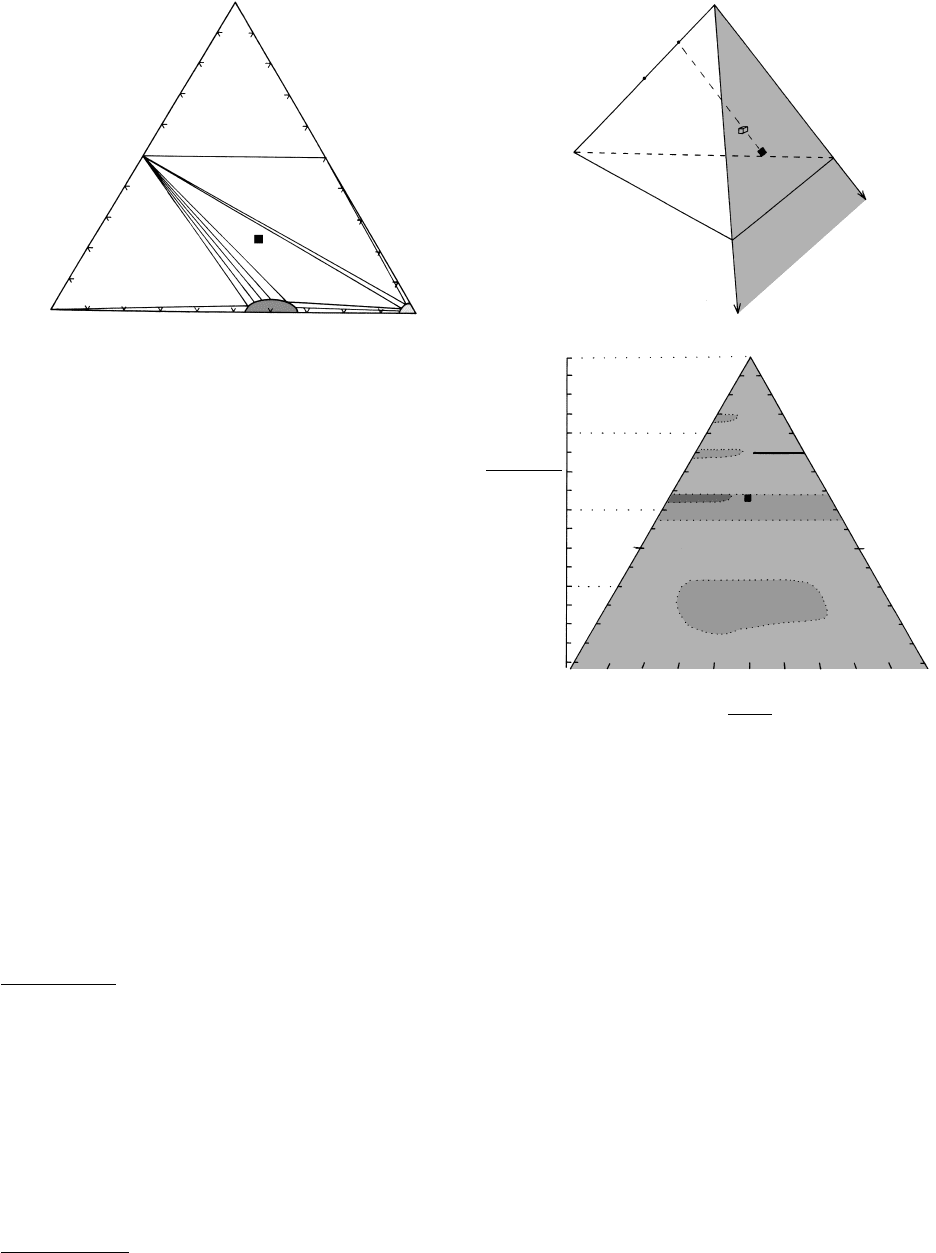Myron G. Best. Igneous and metamorphic 2003 Blackwell Science
Подождите немного. Документ загружается.


terrane. If a system is at least divariant (F 2), the
phase rule C 2 F becomes C 2 2 or
C , so that the number of phases is less than or
equal to the number of components in the system. This
is Goldschmidt’s mineralogical phase rule, so named
because of its formulation by V. M. Goldschmidt in
1912.
Dealing with Components. In constructing two-
dimensional diagrams on a sheet of paper, we must
somehow deal with the fact that most rocks contain
more than three chemical components, typically many
more, whereas the most that can be represented in a
simple manner is three, at the apices of a triangle.
Consequently, compromises and assumptions must be
made in selecting which components are to be plotted
in a particular diagram to depict critically important
phases in the rock system. These assumptions can
compromise the rigor and accuracy of the graphical
analysis, but if they are not forgotten, three-component
triangular diagrams can provide useful information
and visualization of metamorphic mineral equilibria
related to bulk-rock composition under restricted P–T
conditions.
Plotted components should be those that are most
responsible for governing the stability of a particular
mineral assemblage and variations in composition of
the phases in it. Trace elements are always ignored.
The following guidelines can be used to reduce the
number of actual major-element components in a rock
down to the three most relevant ones.
1. A component occurring in essentially one phase
that is chiefly responsible for its stabilization, re-
gardless of its modal amount in the rock, need not
be considered. Thus, in rocks that contain titanite
or ilmenite, TiO
2
can be ignored, as can apatite
(P
2
O
5
), and albite (Na
2
O).
2. A component that occurs in a pure phase, such as
SiO
2
in quartz, TiO
2
in rutile, and Fe
2
O
3
in
hematite need not be considered. An alternate way
of viewing silica, and other similar components of
this nature, is that variations in concentration
(within limits) simply change the modal amount of
the corresponding phase and do not change the
value of the chemical potential of the component
that influences mineral equilibria (Section 3.4.3).
3. H
2
O and other “mobile” components (see Section
16.8.3) whose chemical potentials are dictated by
conditions external to the rock system can be ignored.
4. Less components may be required if the composi-
tional range of rocks considered is restricted in
some way. Thus, instead of attempting to represent
an entire metamorphic facies in one diagram,
several diagrams depicting chemical subcategories
might be employed.
5. Components may be combined, such as FeO,
MnO, and MgO, because of the widespread sub-
stitution of the cations in mafic minerals. However,
two or more mafic minerals may be stable under
certain metamorphic conditions and their com-
positional relations cannot be distinguished in a
triangular diagram where the three components are
combined at one apex.
6. In pelitic rocks, two or more mafic minerals coexist
in many assemblages, making a combination of
FeO, MnO, and MgO into one component inadvis-
able. In many assemblages, a particular component,
such as Al
2
O
3
, occurs in two or more phases and
one phase is found in all of the assemblages under
consideration, such as muscovite in low- to moderate-
grade pelites (Table 14.2). In this case, phases may
be “projected” from the one common phase
through a three-dimensional tetrahedron that rep-
resents four components onto a suitable “projec-
tion plane,” effectively reducing the number of
components by one. This procedure is explained
below for the AFM diagram.
15.3.2 Examples of Composition Diagrams in
Hypothetical Three-Component Systems
Diagrams without Solid Solutions
. Relations between
phases and components in them in a hypothetical rock
system can be depicted in a equilateral triangular dia-
gram where the apices represent three components,
here called h, k, and l (Figure 15.24). At equilibrium, P,
T, and fluid activities have freely varying but restricted
values, so the mineralogical phase rule applies. Hence,
the number of phases constituting a stable assemblage
cannot exceed three, the number of components,
Petrography of Metamorphic Rocks: Fabric, Composition, and Classification
467
K
HKL
H
2
L
HK
B
H
h
A
k
L
l
15.24 Composition, or compatibility, diagram involving no solid
solutions.

or C . Only pure crystalline phases, lacking solid
solution, are stable in this hypothetical rock system.
Tie lines connect phases that coexist stably together.
Any arbitrary point within the triangle represents the
bulk chemical composition of a rock in terms of the
proportions of its three constituent components h, k,
and l. The position of the point within any of the five
subtriangles depicts the three stably coexisting phases
constituting the rock and their proportions. The three-
phase assemblage in rock B consists mostly of L and
H
2
L with lesser HKL; exact proportions can be deter-
mined in the manner of Figure 2.3b by dividing the
sides of the three-phase subtriangle into equal propor-
tions and drawing lines through the rock point parallel
to one triangle side and intersecting the other two.
Rock A consists only of the two phases K and HKL, in
equal proportions from the lever rule (Figure 5.5).
Composition diagrams are sometimes called compat-
ibility diagrams because they depict stably coexisting
phases in mineral assemblages formed at equilibrium
under particular restricted conditions in a particular
bulk-rock chemical category, such as pelites in the
garnet zone in a Barrovian terrane. Three aspects of
this permissive compatibility are worth emphasizing.
First, in such a category and zone equilibrating under
restricted P–T-fluid conditions, all of the phases in the
diagram are stable, but certain ones are incompatible
and should never coexist stably together within one
rock. Thus, the phases K and H
2
L in Figure 15.24 are
incompatible and the k-rich rock A that contains K
cannot also contain H
2
L but it will contain a stable
phase rich in h and l, namely, HKL. Second, not all
rocks represented in the diagram contain all stable
phases. Thus a possible index mineral that defines the
zone might be HKL. Although it is a compatible phase
in most mineral assemblages in widely varying rocks,
and therefore serves admirably as an index mineral, it
is not stable in the most h-rich rocks that contain phase
H. Third, as metamorphic conditions change, mineral
reactions occur that cause loss or gain of new phases
and compatibilites change and create new mineral
assemblages; these changes result in a reconfiguration
of tie-lines in a particular sort of diagram for successive
zones or facies.
Diagrams that Contain Solid Solutions. Consider a
hypothetical system composed of the components w,
y, and z (Figure 15.25). Under some restricted set of
conditions, two of the possible phases in the system, W
and Y, are pure crystals with no solid solution; they are
represented by points. Four of the possible phases are
solid solutions. Z
ss
and WYZ
ss
have variable concentra-
tions of all three components and are represented by
an area in the triangle. Solid solutions W(Y,Z) and
W
2
(Z,Y) have variable amounts of only y and z and so
are represented by line segments parallel to the yz base
of the composition triangle. The extent of the line or
area indicates the limits of solid solubility. Because of
the four solid solutions, the extent of subtriangular
stability fields of three-phase assemblages is reduced,
compared to those in Figure 15.24, whereas two-phase
assemblages, now represented by bands or bundles of
tie lines rather than a single tie line, are more extensive.
Three-phase assemblages represented by triangular
areas within Figure 15.25 are divariant, F 3 2 3
2. The composition of each crystalline solid solution
is uniquely fixed if P and T are uniquely specified. For
example, the exact composition of each phase located
at the apices of the three-phase triangle (shaded in
Figure 15.25) Y + WYZ
ss
+ Z
ss
is indicated by the solid
squares. Any rock within the same range of P and T
whose bulk chemical composition lies within that
three-phase triangle consists of the same three phases
represented by the solid squares; modal proportions of
these phases vary, however, with changes in bulk com-
position of the rock.
Two-phase assemblages are denoted by a band of tie
lines, only a few of the infinite number that could be
drawn. Because of the loss of a phase, there is a corres-
ponding additional degree of freedom so that such
equilibria are trivariant, F 3 2 2 3. Besides the
independently varying P and T, one compositional
parameter is also independent (the system is composi-
tionally univariant). Specification of the mole fraction
of just one component in one phase and the exact P
and T is sufficient to define completely the composition
of both phases. For example, rock D consists of WYZ
ss
W
2
(Z,Y); if the mole fraction of component y in the
latter phase is 0.10, then the mole fractions of w, y, and
z, in WYZ
ss
are fixed at the other end of the tie line as
468 Igneous and Metamorphic Petrology
Y
WYZ
ss
W
2
(Z,Y)
W(Y,Z)
E
W
w
y
Z
z
Z
ss
D
15.25 Composition, or compatibility, diagram involving solid
solutions.

0.36, 0.31, and 0.33, respectively. For a particular P and
T, there is a unique tie line that connects a specific
W
2
(Z,Y) solid solution (open square) to a specific
WYZ
ss
in equilibrium with it (open square), allowing
its composition to be read from the diagram. The
modal proportions of these two phases constituting
rock D are given by the lever rule (Figure 5.5), namely,
75% of W
2
(Z,Y) and 25% of WYZ
ss
. A limited range
of rocks can be composed of the same two phases
and variations in their chemical bulk composition are
accommodated by variations in modal proportions of
the two phases and their chemical composition.
A rock system plotting within a one-phase area in
Figure 15.25 has four degrees of freedom, F 3 2
1 4. The composition of rock E, consisting entirely
of Z
ss
, can only be completely and uniquely defined by
specifying the mole fractions of two of the three com-
ponents and the exact P and T. A variety of rocks that
plot in the area labeled Z
ss
can be composed exclusively
of Z
ss
; their differences are reflected in the different
compositions of Z
ss
. Any composition of Z
ss
that coex-
ists with another phase, such as Y, is constrained to lie
on the edge of the Z
ss
area facing Y and a degree of
freedom is lost as a phase is gained.
15.3.3 Compatibility Diagrams for
Metamorphic Rocks
Several different compatibility diagrams have been
employed by petrologists to depict compositional
relations in metamorphic rocks. Three are considered
here.
ACF Diagram. For metamorphosed mafic rocks as
well as shaly limestones and dolomites the ACF dia-
gram has been used since its conception by Eskola in
1915. FeO, MgO, and MnO are lumped together as
one component, F, where anthophyllite, cummingtonite,
hypersthene, olivine, and other Fe–Mg silicates plot.
However, despite this inconvenience, two additional
components can be displayed. The values of the com-
ponents A, C, and F are determined as follows (see also
Table 15.2 and Figure 15.26):
1. Obtain molecular proportions of oxides from the
chemical analysis of the rock or mineral by dividing
their wt.% by their formulae weight (see Appendix
B; although this appendix deals with calculation of
the norm for magmatic rocks the manner in which
minerals are represented on a molecular basis is
similar to that in composition diagrams for meta-
morphic systems and should, therefore, be reviewed
at this point).
2. Component A equals the molecular proportions
of Al
2
O
3
plus Fe
2
O
3
minus Na
2
O and K
2
O; that is,
A Al
2
O
3
Fe
2
O
3
(Na
2
O K
2
O). Fe
2
O
3
is added to Al
2
O
3
because of the common sub-
stitution of Fe
3
for Al
3
in many minerals. In
subtracting Na
2
O and K
2
O, the amount of Al
2
O
3
remaining is the excess over that required to make
Petrography of Metamorphic Rocks: Fabric, Composition, and Classification
469
Table 15.2. Chemical Composition of Basalt BCR-1 in Table 2.1 and Calculation of A, C, and F Plotted in
Figure 15.26
W
T
.% M
OLECULAR
PROPORTION
SiO
2
54.06 A mol. prop. Al
2
O
3
mol. prop. Fe
2
O
3
mol.prop. Na
2
O mol. prop. K
2
O
Al
2
O
3
13.64 0.134 0.134 0.021 0.053 0.018
Fe
2
O
3
3.28 0.021 0.084
FeO 8.88 0.124
MgO 3.48 0.086 C mol. prop. CaO 3.33 mol. prop. P
2
O
5
– mol. prop. CO
2
CaO 6.95 0.124 0.124 0.010 0.001
Na
2
O 3.27 0.053 0.113
K
2
O 1.69 0.018
TiO
2
2.24 0.028 F mol. prop. FeO mol. prop. MgO mol. prop. MnO
mol. prop. TiO
2
mol. prop. Fe
2
O
3
P
2
O
5
0.36 0.003 0.124 0.086 0.003 0.028 0.021
MnO 0.18 0.003 0.164
CO
2
0.03 0.001
Total 98.37
A C F 0.084 0.113 0.164 0.361
%A (0.084/0.361)100 23.3
%C (0.113/0.361)100 31.3
%F (0.164/0.361)100 45.4

up alkali feldspar, which will occur in solid solution
in plagioclases in mafic and Ca-rich rocks but only
rarely as a distinct phase. Recall the 1:1 ratios of
K
2
O and Na
2
O to Al
2
O
3
in alkali feldspar (Table
14.1). (If muscovite or biotite are present, this cal-
culation for A is invalid). Alternatively, the subtrac-
tion of Na
2
O and K
2
O from Al
2
O
3
is equivalent to
a projection from alkali feldspar (see the AFM pro-
jection below).
3. Component C CaO 3.3P
2
O
5
CO
2
. These
subtractions allow for the presence of ideal apatite
(3.3CaO·P
2
O
5
) and calcite (CaO·CO
2
).
4. Component F FeO MgO MnO. Molecular
proportions of TiO
2
and Fe
2
O
3
may be subtracted to
allow for the presence of ideal ilmenite (FeO·TiO
2
)
and magnetite (FeO·Fe
2
O
3
), respectively.
5. The sum of A C F is found and the propor-
tions of A, C, and F calculated for plotting, as in
Figure 15.26.
AKF Diagram. The AKF diagram is useful for rep-
resentation of potassic minerals, such as micas and
alkali feldspars, in pelitic rocks. The three components
are formulated as in the ACF diagram, except A is
different.
1. A Al
2
O
3
Fe
2
O
3
(Na
2
O K
2
O CaO).
This formulation eliminates plagioclase from the
diagram.
2. K K
2
O.
3. F FeO MgO MnO.
AFM Projection. The AFM projection for pelitic rocks
was conceived by Thompson (1957). It employs a pro-
jection from either muscovite or K-feldspar on the edge
of a tetrahedron, each corner of which represents a
component and inside which lies a point representing
the bulk chemical composition of a pelitic rock (Figure
15.27a). To reduce the number of relevant components
to four to be represented in the tetrahedron the fol-
lowing assumptions and simplifications are made. SiO
2
is generally present in sufficient concentrations so that
quartz is present in all assemblages and from 2 in Sec-
tion 15.3.1 can be ignored. H
2
O can also ignored on
the basis of 3 above but it must be realized that a
particular diagram applies only for a particular activity
(effective thermodynamic concentration, Section 3.5.1).
470 Igneous and Metamorphic Petrology
Opx
(01)
Clinopyroxene
BCR
1
Calcite
C
Plagioclase
Spinel
A
magnetite
ilmenite
F
15.26 ACF diagram for basaltic and gabbroic mineral assemblages
with the basalt BCR-1 from Table 2.1 plotted as a square. Note
extensive solid solution in clinopyroxene solid solution (dark
shaded).
15.27 Thompson AFM molecular projection. Mineral abbreviations
as in Table 14.1. (a) Complete three-dimensional AFMK
tetrahedron showing average shale from Table 15.3 within
the tetrahedron (open square) and its projection (filled square)
from ideal muscovite onto the extended AFM projection face
(shaded). (b) AFM projection from ideal muscovite (and
quartz and water) showing average shale (filled square) and
range of composition of aluminous silicate solid solutions
occurring in pelitic rocks. Tick marks on sides of AFM tri-
angle are lines parallel to base that represent molecular ratios
of A/(A F M) as shown in scale on left. Tick marks on
bottom edge of AFM triangle that can be extrapolated to the
A apex are molecular ratios of M/(F M).
Bt
Al
2
SiO
5
Quartz
Muscovite
H
2
O
A
K
M
F
Muscovite
K-feldspar
Average
shale
(b)
(a)
A
A F M
1.0
0.6
0.2
0.0
–0.2
–0.6
1.00.80.60.40.20.0
A
St
Cld
Crd
Grt
FM
SHALE
Ch1
M
F M

Fe
2
O
3
, MnO, CaO, Na
2
O, and TiO
2
are generally in
small enough concentrations in pelitic rocks that they
merely stabilize a distinct phase rich in the component
or substitute for other major components (1 and 5
above). Four remaining major components—Al
2
O
3
,
FeO, MgO, and K
2
O—are responsible for most of
the mineralogical variations observed in pelitic rocks,
including compositions of index minerals such as chlo-
rite, biotite, garnet, and so on in the classic Barrovian
zones. An advantage of the AFM projection is its
representation of FeO and MgO as separate com-
ponents so as to depict differing Fe–Mg partitioning
and ratios in several common mafic minerals in pelitic
assemblages.
The next step is to project all compositional points,
lines, areas, and volumes within the AFMK tetrahe-
dron onto the AFM face, with muscovite as the point
from which the projection is made (Figure 15.27). An
ideal composition for muscovite, KAl
2
AlSi
3
O
10
(OH)
2
,
is assumed, although real muscovites can deviate from
this significantly. In projecting from muscovite, the
AFM plane must be extended below the KFM plane to
catch all of the pertinent compositional features inside
the tetrahedron. Choice of muscovite as a projection
point is justified by the fact that it is a widespread
mineral in nearly all low- to intermediate-grade pelitic
rocks. In a sense, it has a status like quartz in being
present in excess with all the assemblages represented
in the diagram. K-feldspar may be used as a projection
point for higher-grade rocks. Choice of AFM as the
plane of projection is justified by the fact that most crit-
ical minerals in pelitic rocks lie on it, or are close to it.
The detailed steps for calculation of the AFM com-
ponents are as follows, noting that the formulation of A
and F differ from that for the ACF and AKF diagrams
(see Table 15.3):
1. A Al
2
O
3
3K
2
O. This subtraction is the arith-
metic technique of projecting from the ideal mus-
covite composition point onto the AFM face of the
AFMK tetrahedron because in ideal muscovite
there are three times as many moles of Al
2
O
3
as
K
2
O. The amount of A needs to be the amount of
Al
2
O
3
left over after removing (“projecting from”)
muscovite. If the projection is from K-feldspar that
is present in a higher-grade mineral assemblage
rather than muscovite then A Al
2
O
3
K
2
O.
2. F FeO. If ilmenite (FeO·TiO
2
) is a member of
the mineral assemblage, then the molecular pro-
portion of TiO
2
in the rock must be subtracted
from the molecular proportion of FeO to obtain
F. This subtraction is the arithmetic technique of
making ilmenite a part of the assemblage; altern-
atively, it could be said that ilmenite is present in
excess or that the projection is from ilmenite in the
AFMK tetrahedron as well as from muscovite.
3. M MgO.
4. The amounts of A, F, and M are summed, recalcu-
lated in terms of proportions, and plotted on the
extended AFM projection plane using a grid of
their ratios (Figure 15.27).
Where quartz is present, as is the usual case in pelites,
the AFM projection may also be from quartz as well as
from muscovite (or K-feldspar) and possibly ilmenite.
As a reminder that these phases coexist with the min-
eral assemblages portrayed on the AFM projection,
they are listed alongside the diagram as, for example, in
Figure 15.27b.
SUMMARY
Understanding the fabric of a metamorphic rock is
essential to an interpretation of its evolution as well as
to its classification. Relict fabrics are commonly pre-
served in low-grade and weakly metamorphosed rocks.
With increasing degree of recrystallization, especially
at higher grades, protolith fabrics are erased by grain
boundary adjustments. The increasing overprint of
imposed metamorphic fabric reflects the state of stress
during metamorphism. Isotropic fabrics form under
hydrostatic stress conditions, whereas anisotropic, or
tectonite, fabrics develop during ductile deformation
under nonhydrostatic stresses; their geometric pattern
—whether planar, linear, or planar-linear—reflects the
pattern of ductile flow and how it interacts with the
rock body.
Petrography of Metamorphic Rocks: Fabric, Composition, and Classification
471
Table 15.3. Chemical Composition of Average Shale
(Boggs, 1995) and Calculation of A, F, and M plotted
in Figure 15.27
W
T
.% M
OLECULAR
PROPORTION
SiO
2
63.31 A mol. prop. Al
2
O
3
3 (mol. prop. K
2
O)
TiO
2
0.81 0.169 – 3(0.0386)
Al
2
O
3
17.22 0.1690 0.0532
Fe
2
O
3
0.82
FeO 5.45 0.0759 F mol. prop. FeO
MgO 3.00 0.0744 0.0759
CaO 3.52
Na
2
O 1.48 M mol. prop. MgO
K
2
O 3.64 0.0386 0.0744
P
2
O
5
0.1
MnO 0.06 A/(A F M) 0.260
M/(F M) 0.495
Total 99.41

In contrast to the intricate and generally quantitative
classification of magmatic rocks, that for metamorphic
rocks is simpler and more flexible; it is based on the
protolith, rock composition, and metamorphic fabric,
conditions, and setting. The relict fabric and composi-
tion allow a rock to be classified in terms of its pro-
tolith as, for example, a metaconglomerate, metatuff, or
orthogneiss. Most metamorphic rocks can be classified
into one of three broad categories of metamorphic
fabric, namely:
1. Strongly foliated slate, phyllite, and schist of in-
creasing grain size that are found over widespread
regional metamorphic terranes.
2. Weakly foliated rocks that include gneiss, dynamic-
ally recrystallized mylonite in ductile shear zones,
and migmatite developed in deep crustal, high-
grade terranes.
3. Essentially nonfoliated amphibolite, granofels,
greenstone, marble, quartzite, and serpentinite
are widespread in regional terranes, whereas
charnockitic rocks are less common and eclogite
rare. Isotropic-textured hornfels is developed by
thermal metamorphism, most commonly of pelitic
protoliths, in contact aureoles around magmatic
intrusions. Metasomatic skarn, greisen, and fenite
are also developed around magmatic intrusions,
whereas rodingite and spilite are created by re-
placement processes near bodies of serpentinitizing
ultramafic rocks and from seafloor basalt near
oceanic ridges, respectively.
Widespread veins, most commonly of quartz, testify
of advecting hydrothermal solutions moving through
metamorphosing rock masses.
By judicious choice of relevant components, the bulk
chemical compositions of rocks and their constituent
mineral assemblages may be plotted on an appropriate
triangular composition diagram to assess compatibilit-
ies for a restricted range of P–T-fluid composition.
CRITICAL THINKING QUESTIONS
15.1 Justify the use of so few metamorphic rock
names relative to magmatic.
15.2 A sequence of shales and shaly dolomites next
to a magmatic intrusion has been recrystallized
to granoblastic rocks that have conspicuous
relict bedding. Constituent minerals are several
Ca–Al–Mg–Fe silicates. Comparison of their
bulk chemical composition with beds of un-
metamorphosed rocks along strike some dis-
tance away indicates the major chemical change
is restricted to a loss of H
2
O and CO
2
. What
would you name these metamorphic rocks? Jus-
tify your answer.
15.3 Why cannot metamorphic facies be used for
classification of an individual rock sample?
15.4 What are possible protoliths of a quartz–
feldspar granofels? How could it be distin-
guished from a unmetamorphosed granitoid?
15.5 What is the origin of secondary magnetite in
serpentinite? Would you expect the magnetite
grains to be robust euhedra as they commonly
are in magmatic rocks (e.g. Figures 7.9 and
7.16)? Discuss.
15.6 Imagine a planetary body entirely lacking in
volatiles. How would this lack impact the
classification of metamorphic rocks examined
by a geologist roaming over the surface of the
planet?
15.7 Is serpentinite a metasomatic rock? Discuss.
15.8 What arguments could you present to justify the
metasomatic origin of spilite, rather than direct
crystallization from a unique spilite magma?
15.9 Using any chemical analysis of a basaltic rock in
this textbook, indicate where the major and mi-
nor elements are sequestered in the minerals of
an eclogite (clinopyroxene garnet rutile).
472 Igneous and Metamorphic Petrology

F
UNDAMENTAL
Q
UESTIONS
C
ONSIDERED IN
T
HIS
C
HAPTER
1. What types of mineral reactions allow
metamorphic systems to attain new states of more
stable thermodynamic equilibrium?
2. What parameters govern mineral reactions and
how can they be evaluated and graphed to depict
the course of changing metamorphic systems?
3. How does the composition of fluids influence
metamorphic mineral reactions?
4. What do metamorphic reactions tell about the
flow of fluids in the crust? About the significance
of isograds?
5. How can mineral equilibria and assemblages
serve as geothermobarometers to elucidate P–T
conditions of metamorphism?
INTRODUCTION
Changes in P, T, and/or X (chemical composition) of
sufficient magnitude in a metamorphic system can
create a new state of more stable thermodynamic equi-
librium. Any new mineralogical state is reached via one
or more mineralogical reactions that consume initial
less stable reactant phases in favor of new, more stable
product phases. Concepts of equilibrium thermody-
namics (Chapter 3) provide a fruitful context for study
of these changes.
Great strides have been made over the past decades
in our understanding of the metamorphic changes
driving mineral reactions and forming specific mineral
assemblages. This understanding of mineral paragene-
sis has come from extensive laboratory studies fostered
by development of experimental apparatus and tech-
niques that simulate P–T–X conditions in metamor-
phic systems and by determinations of thermodynamic
parameters that can be applied to mineral equilibria.
However, experimental data regarding paragenesis in
subsolidus metamorphic systems must be interpreted
cautiously because of widespread kinetic problems
with metastable phases, especially those preserved
from some prior state. For the same reasons, miner-
alogical compositions of real metamorphic rocks must
be interpreted cautiously; disequilibrium states are
common.
The history of mineral reactions can be preserved in
reaction textures in which products of mineralogical
reactions as well as remaining relics of the initial
reactant minerals are found in close spatial association.
Examples of reaction textures include pseudomorphic
replacement of garnet by aggregates of chlorite in
the retrograded eclogite in Figure 14.27b, replace-
ment of olivine and orthopyroxene by serpentine
(Figure 15.21), and coronas (see Figure 16.6). But even
deceptively simple pseudomorphic replacements can be
difficult to interpret; it is generally impossible to write
a balanced stoichiometric reaction for something as
simple as anhydrous phase H
2
O → hydrous phase.
Local, grain-scale changes in chemical composition
during open system behavior are probably the rule
rather than the exception. An equally serious problem
is that reaction textures are distressingly uncommon
in metamorphic rocks. Grains of product phases com-
monly do not grow directly in contact with grains of
reactant phases, as in pseudomorphic replacements.
Rather, reactants and products may be separated by
Metamorphic
Mineral Reactions
and Equilibria
16
CHAPTER
grains that seemingly did not participate in the reac-
tion. Textural evidence for a mineral reaction across an
isograd in a metamorpic terrane may not be obvious.
Careful integration of all textural and mineralogical
properties of rocks may be required to comprehend
past reactions.
Plentiful evidence indicates that fluids are intimately
involved in many, if not most, metamorphic mineral
reactions, either liberated from reacting phases, incorp-
orated into product phases, or indirectly involved as
a catalyst and medium of ionic transport. In many
metamorphic rocks, the availability of a catalytic inter-
granular fluid is deemed to be kinetically necessary to
account for various mineralogical and textural aspects.
In a larger geologic sense, flow of fluids during meta-
morphism has a profound impact not only on the
course of mineral reactions but also on movement of
mass and heat in the crust.
This chapter begins with a summary of criteria
for evaluation of mineral equilibrium in metamorphic
rocks. Following discussions of mineral reactions begin
with solids of fixed composition, progress to those in-
volving solid solution and then to reactions in which a
fluid plays a critical role and, lastly, treat reactions in
fluid-rich open metasomatic systems. The chapter con-
cludes with comments on the role of kinetics in mineral
reactions and how they might actually take place, and,
finally, how mineral equilibria can be used in geother-
mobarometry to determine the T and P of metamor-
phism and to assess isograds in zoned metamorphic
terranes.
Four major books—all published at about the same
time by established petrologists—deal with metamor-
phic mineral equilibria and reactions. Bucher and Frey
(1994) and Miyashiro (1994) are essentially descriptive,
whereas Kretz (1994) and Spear (1993) provide a more
rigorous thermodynamic approach. A recent well bal-
anced summary is Winter (2001).
Mineral abbreviations used in this chapter are from
Table 14.1.
16.1 EQUILIBRIUM MINERAL
ASSEMBLAGES
In metamorphic terranes, equilibration of minerals to
prevailing P–T conditions is suggested by consistent
correlations between mineralogical composition and
bulk chemical composition—as embodied in the facies
concept—and by systematic geographic variations in
mineralogical composition in a particular chemical
rock group—reflected in metamorphic zones. It may
be necessary to identify and distinguish between con-
trasting bulk chemical domains, if such are present.
For example, layers of calc–silicate and pelitic rock
metamorphosed under the same P–T conditions
will have different stable mineral assemblages, each
developed in a state of local equilibrium. On the scale
of a thin section, verification of what coexisting min-
erals constitute a stable equilibrium mineral assemblage
is not easy, especially in polymetamorphic rocks. The
following criteria for equilibrium (e.g. Vernon, 1977;
Yardley, 1989) should be evaluated, keeping in mind
that they are only necessary conditions, never sufficient
to prove stable equilibrium. Some criteria are textural
(see Chapter 17).
1. Absence of known incompatible mineral pairs,
such as quartz magnesian olivine (Figure 5.8) or
hematite graphite. Stabilization of hematite re-
quires relatively oxidizing conditions of high oxy-
gen fugacity, whereas graphite requires relatively
low oxygen fugacity.
2. All phases are in mutual contact with one another,
with due recognition of the third dimension above
and below the plane of the two-dimensional thin
section. Grains of new phases tend to nucleate and
grow along intergrain boundaries; consequently, if
a particular mineral grain becomes isolated from
the intergrain network it may be unable to react
further and equilibrate with diffusing components.
A particular phase occurring only as grains inside
a corona or only as inclusions in a poikiloblast
should thus be suspect, as it may belong to an earl-
ier assemblage of minerals. On the other hand, a
particular mineral might selectively nucleate on
another, such as sillimanite on biotite (see Figure
16.2), precluding mutual contact with all other
equilibrium phases in the rock.
3. No evidence of replacement of one mineral by
another. Aggregates of chlorite fringing garnet or
having the typical dodecahedral outline of garnet
(Figure 14.27b) are likely to be a product of retro-
grade hydration, as are fine grained white mica re-
placements of Al
2
SiO
5
polymorphs and feldspars.
Caution is required where relict primary grains in
a magmatic rock are selectively replaced by fine
aggregates of specific minerals under essentially
equilibrium conditions and where partial replace-
ment results from an arrested reaction caused by
exhaustion of a reacting phase, including a fluid.
4. Absence of grain domains showing deformation
adjacent to domains showing strain-free grains that
might have grown under different conditions (see
Section 17.3).
5. Grains have shapes indicative of minimum surface
energy such as develop in granoblastic aggregates
(Figure 14.6c, d) and where a crystalloblastic series
is expressed (Section 14.1.4 and Figure 14.17d).
Texturally equilibrated grain shapes may not be
equant if the mineral in question possesses strong
energy anisotropy (see Section 17.1.2). In fine-
grained low-grade rocks or other instances where
474 Igneous and Metamorphic Petrology
time was insufficient to equilibrate the texture, grains
will not have equilibrated shapes (Figure 14.6a)
even though a state of chemical equilibrium may
have been achieved. Chemical equilibrium tends to
be attained faster than textural equilibrium.
6. Microprobe analyses reveal mineral grains are uni-
form in composition so that the distribution of
chemical elements is similar between pairs of min-
erals in different parts of the rock. If a particular
phase occurs as zoned grains, the edges of several
grains which are all adjacent to grains of another
phase should be of similar composition. This criter-
ion manifests a state of local equilibrium. Interiors
of zoned grains may not be in equilibrium with
other phases (2 above).
16.2 OVERVIEW OF METAMORPHIC
MINERAL REACTIONS
Mineral reactions can be classified with regard to
the phases that are involved (A and B below) or with
regard to the reaction mechanisms and equilibrium
conditions (C and D).
A. Solid–solid reactions involve only solid phases as
reactants and products without direct participation
of a volatile phase. A fluid may, nonetheless, be a
passive or indirect catalytic participant, enhancing
nucleation and providing a medium for diffusive
transport of ions redistributed during growth of the
new products.
B. Solid–fluid reactions (Section 16.6) release or con-
sume a volatile fluid and depend not only on P and
T but the composition of the volatile as well. Redox
reactions (Section 16.9) are driven by changes in T
and fugacities of volatiles, principally oxygen, and
result in changes of oxidation states and types of
variable-valence phases in assemblages. Metasomatic
reactions (Section 16.8) occur in open metamorphic
systems where exchange of components between
invasive fluids and the solid phases in a rock results
in an entirely new product mineral assemblage.
C. Discontinuous reactions occur, ideally, at a single T
at a particular P. Reactant and product phases are
in equilibrium along a univariant boundary line
(Section 5.1.1) in P–T space. Discontinuous reac-
tions are of two types:
1. Polymorphic phase transitions (Section 16.3)
involve transformation of one solid phase to
another of identical chemical composition but
different atomic structure in a one-component
system, such as calcite → aragonite.
2. Net-transfer (heterogeneous) reactions (Sec-
tion 16.4) involve marked movement of matter
among multiple phases, consuming reactants
and producing new phases. Modal proportions
of the compositionally contrasting phases change
during the course of the reaction.
D. Continuous reactions (Section 16.5) are continu-
ously at equilibrium over a range of values of the
controlling intensive variables as a result of sub-
stantial compositional variation (solid solution) in
the reactant and product phases. Chemical com-
positions of participating phases and their modal
proportions change during the course of the reac-
tion. A continuous reaction becomes a discon-
tinuous one if only pure end-member phases are
considered. An exchange reaction (Section 16.5.2)
is a special subclass in which there is no change in
modal proportions of reactant and product phases,
only in the concentrations of substitutive ions,
such as Fe and Mg, changing the Fe/(Fe Mg)
ratio in participating mafic garnet, cordierite, and
so on.
Except for polymorphic transitions, most reactions
in metamorphic rocks are combinations of these ideal
end-member types.
16.3 POLYMORPHIC TRANSITIONS
The presence of a polymorph can potentially provide
important constraints on P–T conditions in the appro-
priate chemical categories of a rock where it occurs
because only these two intensive parameters control
the stability of the phases of like chemical composition.
In theory, polymorph stability and positions of bound-
ary lines in P–T space are unaffected by other chemical
components than those making up the pure poly-
morphs themselves and that do not dissolve in the
polymorphs. Thus, phase equilibria between quartz
and coesite in a SiO
2
system flooded with CO
2
or in
the presence of CaO and FeO are no different from
the pure system without these additional components.
It should also be noted that kinetic factors can com-
promise the stability relations of polymorphs in rocks.
In any stability field of a particular polymorph, both
P and T can be freely and independently varied with-
out any perturbation in the state of equilibrium. This
is a state of divariant equilibrium where there are two
degrees of freedom, F 2. Divariant stability fields
are separated by univariant boundary lines where two
phases coexist stably together. This decrease in the
variance in systems of fixed composition follows from
the Gibbs phase rule (Section 5.1.1): for every increase
in the number of phases the degree of freedom de-
creases by one. From the Clapeyron Equation (3.13),
boundary lines are straight provided the changes in
entropy and molar volume, S and V, of the poly-
morphic transition are constant and do not vary with
respect to P and T, or variations in these parameters
Metamorphic Mineral Reactions and Equilibria
475

cancel out as P and T change. From this equation, the
lines can have any orientation and positive or negative
slope depending on the relative values of S and V.
The univariant boundary line between the quartz
and coesite stability fields has already been shown in
Figures 5.1 and 5.11. It is readily apparent that the
stability field of the coesite polymorph lies at a con-
siderable depth—more than about 110 km, assuming
a low geothermal gradient of only 7°C/km; a higher
gradient would restrict the stability field to even higher
pressures. Hence, coesite occurs only in ultrahigh-P sil-
icate metamorphic rocks equilibrated at exceptionally
high pressures in continent–continent collision zones
and in some meteorite impact sites where transient
shock waves stabilized the polymorph. The low-P poly-
morph tridymite occurs in some very rare sanidinite-
facies rocks (Table 14.2).
Amorphous carbon derived from organic material
is common in clay-rich rocks. At higher grades under
reducing (low oxygen fugacity) conditions graphite is
stabilized. Minute diamonds occur in very rare rocks
metamorphosed under ultrahigh-P conditions. Stabil-
ity fields of graphite and diamond in P–T space are
shown in Figure 11.5.
Aragonite, the denser, orthorhombic polymorph
of CaCO
3
, forms in many environments at near-
atmospheric conditions. This is a classic example of
metastable nucleation and growth of a mineral well
outside its stability field. However, aragonite does crys-
tallize stably at high pressures in rocks of the blueschist
facies (Figure 16.1). Experimentally determined kine-
tics of the transition of aragonite to rhombohedral
calcite together with trace element concentrations and
fabric observations have been used to track P–T–t
paths of blueschist-facies rocks during exhumation
(e.g. Gillet and Goffé, 1988).
16.3.1 The Al
2
SiO
5
System
The aluminosilicate (Al
2
SiO
5
) polymorphs—andalusite,
sillimanite, and kyanite—are widespread in Al-rich
pelitic metamorphic rocks above the lowest grades
(Kerrick, 1990). At temperatures below about 400°C,
hydrous aluminosilicates, such as kaolinite and pyro-
phyllite, are stable, while andalusite and kyanite are
metastable (see Figure 16.14a). Determination of the
P–T stability fields of the polymorphs in the laboratory
has been beset with kinetic challenges that, to some
extent, mirror the metastable coexistence of two and,
very locally, all three polymorphs in a single rock
sample.
Kinetic Constraints. Experimental difficulties in the
determination of Al
2
SiO
5
equilibria stem from several
factors. Reconstructive polymorphic transitions are
very sluggish because they involve a change in coor-
dination of aluminum and connectivity with Si–O
tetrahedra requiring breaking of strong Al–O and Si–O
bonds. Thermodynamic parameters listed in Table 16.1
are similar for the three polymorphs, especially for an-
dalusite and sillimanite. Hence, changes in free energy,
G, are very small, providing little driving force for the
transitions. Those actually accomplished in the labora-
tory often have involved large overstepping of equilib-
rium conditions to overcome activation energy barriers
for nucleation. Experimentalists have traditionally
used oxides or glasses as starting materials, but in try-
ing to synthesize a particular polymorph, a metastable
one is prone to nucleate preferentially (compare Figure
476 Igneous and Metamorphic Petrology
P (kbar)
Depth (km)
25
20
15
10
5
0
80
60
40
20
0
0 200 400 600 800 1000
T (°C)
Calcite
facies
Blueschist
Aragonite
16.1 Stability fields of the CaCO
3
polymorphs. Thin lines are uni-
variant reaction lines bounding stability fields that have been
determined experimentally by different investigators. Their
scatter hinders using them to accurately ascertain P–T condi-
tions for a polymorph equilibrated under blueschist-facies
conditions (dotted line enclosure). Our preferred boundary
curve (heavy line) is based on calorimetric enthalpy measure-
ments fitted to a theoretical expression of free energy and en-
tropy from Redfern et al. (1989). Depth scale on right is based
on an average continental crustal density of 2.7 g/cm
3
.
Table 16.1. Thermodynamic Data per Mole for the
Al
2
SiO
5
Polymorphs at “Room” T and 1 atm from
Holdaway and Mukhopadhyay (1993)
V (J/
BAR
)* S (J/K) H (
K
J)
Andalusite 5.146 91.60 2589.66
Sillimanite 4.984 95.08 2586.37
Kyanite 4.408 82.86 2593.70
*1 J/bar 10 cm
3
.
